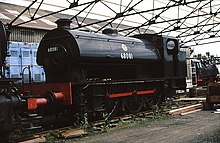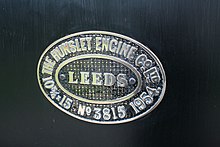Hunslet Engine Company
The Hunslet Engine Company is a
History

The early years 1864–1901

The company was founded in 1864 at Jack Lane in Hunslet by John Towlerton Leather, a civil engineering contractor, who appointed James Campbell (son of Alexander Campbell, a Leeds engineer) as his works manager.
The first engine was completed in 1865. It was Linden, a
In 1871, James Campbell bought the company for £25,000 (payable in five instalments over two years) and the firm remained in the Campbell family ownership for many years. Between 1865 and 1870, the company had averaged fewer than ten locomotives a year but, in 1871, seventeen were built, rising over the next 30 years to a maximum of 34.
In 1870, Hunslet constructed its first narrow gauge engine Dinorwic, a diminutive 1 ft 10+3⁄4 in (578 mm) gauge
Many short wheelbase
The first Hunslet engine built for export was its No. 10, an
From 1873 onwards, many Hunslet locomotives were exported to Australia for use on both main line and lesser lines.[2]
1901–1939
In 1901, James Campbell was still in charge as proprietor and his four sons were all working for the company, including the eldest son Alexander III who had taken over as works manager on the death of his Uncle George in 1890. In 1902, the company was reorganised as a private limited company with the name Hunslet Engine Company Ltd. but was still a family business. Following the death of James Campbell in 1905, the chairmanship passed to Alexander III and brother Robert became works manager, while brother Will retained the role of secretary and traveller with a seat on the board.
At about this time, Hunslet was building a series of
Following family disagreements, both Will and the youngest brother Gordon left the company and a serious injury left Robert disabled and unable to continue as works manager. The post of works manager was advertised and Edgar Alcock, then assistant works manager at the
During the
After the First World War, Hunslet was once more able to attract overseas orders and it also received a series of repeat orders from the
Other independent British manufacturers failed to survive the
1930–2000
John Alcock, who, following in his father's footsteps, became managing director of Hunslet in 1958, recalled his father telling him circa 1920, when he was still a schoolboy, that his main endeavour for the company would be in the application of the internal combustion engine to railway locomotion. Throughout the 1930s, Hunslet worked on the perfecting of the diesel locomotive.

During the
Locomotive construction resumed after the war. Important in post-war production was the Hunslet flame-proof diesel engine for use in the coal mines, as well as further batches of Austerity shunters for the National Coal Board (NCB) and the British Army, and rebuilding some older Austerities, work which continued into the early 1960s. The last three Austerities were sold in 1970, one directly to preservation, one for scrap and one to the NCB.[5]
The last industrial steam engine built in Britain was built at Hunslet in 1971 for export to Trangkil sugar mill in Central Java, Indonesia.[note 2]
The "Jack Lane, Hunslet, Leeds" works was closed in 1995, the last order being a batch of narrow gauge diesel locomotives for tunnelling on the Jubilee Line Extension of the London Underground.[7]
2000–present

In 2004, the Hunslet Engine Company was acquired by the LH Group. Production was moved to Barton-under-Needwood while other operations remained in Leeds.[8]
In 2006, the company manufactured remote-controlled
In 2007, Hunslet began developing a new family of locomotives ranging from shunters to vehicles weighing up to 100 tons.[11] The first locomotive of the new class, the DH60C, a three-axle C diesel hydraulic shunting locomotive, was unveiled in July 2010.[12]
The company also operated a locomotive hire business (including a British Rail Class 08 shunter acquired in 2006[13]), mainly of industrial shunting locomotives.
In 2012, LH Group was sold to
The Hunslet Steam Co.
The Hunslet Steam Co. is part of the LH Group. The company is involved in new-build steam locomotives (including two Quarry Hunslet
Related companies
Hunslet-Barclay Ltd
The locomotive manufacturer Andrew Barclay was acquired by the Hunslet group in 1972, and renamed Hunslet-Barclay. It chiefly undertook maintenance and refurbishment of diesel multiple unit passenger trains at the Andrew Barclay Caledonia Works in Kilmarnock. In 2003, the LH Group acquired the locomotive interests of the company. In October 2007, Hunslet-Barclay went into receivership and in November was purchased by FKI (the owner of Brush Traction) and renamed Brush-Barclay. In 2011, Brush Traction and Brush-Barclay were purchased by Wabtec.[18]
Preserved locomotives


Preserved examples
- No. 1440 Airedale – Preserved and currently stored at Embsay & Bolton Abbey Steam Railway
- No. 1 Brookes
- No. 11 – Preserved and currently undergoing cosmetic restoration at the Middleton Railway
- No. 243 – Preserved and currently undergoing cosmetic restoration at the Fundación Camilo José Cela assignment Madrid Railway Museum (Fundación de los Ferrocarriles Españoles), Spain
- No. 686 Lady Armaghdale – Preserved and on static display at Highley, on the Severn Valley Railway
- No. 1444 Preserved and running at Museum of Transport & Technology, Auckland, New Zealand
- No. 1800 – Preserved and running on the Nene Valley Railway
- No. 1821
- No. 1873 Jessie – Preserved and running on the Pontypool & Blaenavon Railway
- No. 1982 Ring Haw – Preserved and running on the North Norfolk Railway
- No. 2705 Beatrice – Preserved and running on the Embsay & Bolton Abbey Steam Railway
- No. 2868 B&W Engineering –
- No. 3694 Whiston – preserved an in operational condition at the Foxfield Railway though on loan at end of March 2019 at the Churnet Valley Railway
- No. 3715 Primrose No. 2 – Preserved and currently[Embsay & Bolton Abbey Steam Railway
- No. 3782 Arthur – Preserved and undergoing overhaul at the Buckinghamshire Railway Centre
- No. 3783 Darfield No. 1 – Preserved and running on the Chasewater Railway
- Holly Bank No. 3 – Preserved and running on the Chasewater Railway
- Jack's Green – Preserved and currently stored at the Nene Valley Railway
- No. 1589 Newstead – Preserved and undergoing overhaul at the Spa Valley Railway
- Robert Nelson No. 4
- No. 79 "Plum" – 16 inch ST, preserved on static display at the NSW Rail Museum, Thirlmere, Australia
- No. 2705 – 2-6-0+T loco, preserved and currently running at the NSW Rail Museum, Thirlmere, Australia
- No. 1168 – STbuilt in 1914; preserved and on static display at Fort San Andres Museum, Port-of-Spain, Trinidad' under the unofficial number "42"
Ireland
- Tralee and Dingle Light Railway, County Kerry
- Ulster Folk and Transport Museums, County Down[19]
Israel
- Old Gesher Museum, Kibbutz Gesher
Sri Lanka

- Sri Lanka Railways uses Hunslet diesel shunting locomotives in most railway yards.
New Zealand
- NZR/PWD Y class number 542 (Hunslet No. 1444) is preserved at the Museum of Transport & Technology.
See also
- List of Hunslet narrow gauge locomotive designs
Notes
- ^ Two of these still operate on the Ffestiniog Railway and Charles is preserved in the Penrhyn Castle Railway Museum
- ^ This engine was acquired by the Statfold Barn Railway in 2004 and returned to Britain, being regauged and named "Trangkil".[6]
References
- ^ "Locomotive Sale". Canal Archive. 17 May 2004. Archived from the original on 26 November 2015. Retrieved 25 November 2015.
- ^ McKillop, Bob (December 1982). "Hunslet Locomotives in Australia". Australian Railway Historical Society Bulletin: 266–279.
- ^ Rolt 1964, p. 69.
- ISBN 978-0-9547131-4-0.
- ^ Austerity Spares List, p. 32
- ^ "TRANGKIL No.4". www.statfoldbarnwailway.co.uk. Archived from the original on 18 March 2015. Retrieved 25 February 2012.
- ^ "Jack Lane – Built for Hunslet Locomotive Company". Quarry Hunslet. Retrieved 19 January 2021.
- ^ "LH Group Services expands to buy Hunslet Barclay". Rail (480): 19. 4 February 2004.
- "LH acquires Hunslet locos". Entrain (28 April 2004): 8.
- "Turning the clock back". Rail News. 28 July 2010. Archived from the original on 25 August 2011. Retrieved 14 August 2011. - ^ "Locomotives – Mechanical Engineers". John Henderson. Archived from the original on 4 March 2016. Retrieved 27 November 2009.
- ^ "Hunslet Builds New 50 tonne Locomotive for Korea". Hunslet Engine. 18 April 2007. Retrieved 12 January 2012.
- ^ "Hunslet Developing New Shunter". Hunslet Engine. 27 April 2007. Retrieved 14 January 2012.
- ^ "Hunslet launch new locomotive on open days 6th & 7th and 8th July". Hunslett Engine. Retrieved 14 January 2012.
- Abell, Paul (September 2010). "A New Shunter from Hunslet". Today's Railways UK (105): 54–56. - ^ "Hunslet Adds 08 to Fleet". Hunslet Engine. 25 January 2006. Retrieved 24 September 2011.
- ^ "Wabtec buys LH Group for US$48m". Railway Gazette International. DVV Media UK. Retrieved 12 April 2017.
- ^ "Hunslet Engine Company". Hunslet Engine. Retrieved 14 January 2012.
- Rail Express(302): 31. July 2021.
- ^ "Hunslet Steam Co". Hunslet Engine. Retrieved 14 January 2012.
- ^ "Wabtec buys Brush Traction". Railway Gazette International. DVV Media UK. Retrieved 12 April 2017.
- ^ "NORTHERN IRELAND RAILWAYS – Bo-Bo No.102 'Falcon'". Railway Preservation Society of Ireland. Archived from the original on 20 August 2016.
Literature
- Clarke, B. R.; Veitch, C. C. (1986). The Eighteen Inch Gauge Royal Arsenal Railway at Woolwich. Privately published by B.R. Clarke. ISBN 0-948951-00-1.
- Neale, A. (1995). Hunslet Narrow Gauge Locomotives. Plateway Press. ISBN 1-871980-28-3.
- "Second new Hunslet just £152,750!". Railway Magazine. Vol. 153, no. 1270. IPC Media. February 2007. p. 57.
- Rolt, L. T. C. (1964). A Hunslet Hundred: one hundred years of locomotive building by the Hunslet Engine Company. David & Charles.
- Townsley, D. H. (1998). The Hunslet Engine Works. Plateway Press. ISBN 1-871980-38-0.
External links

